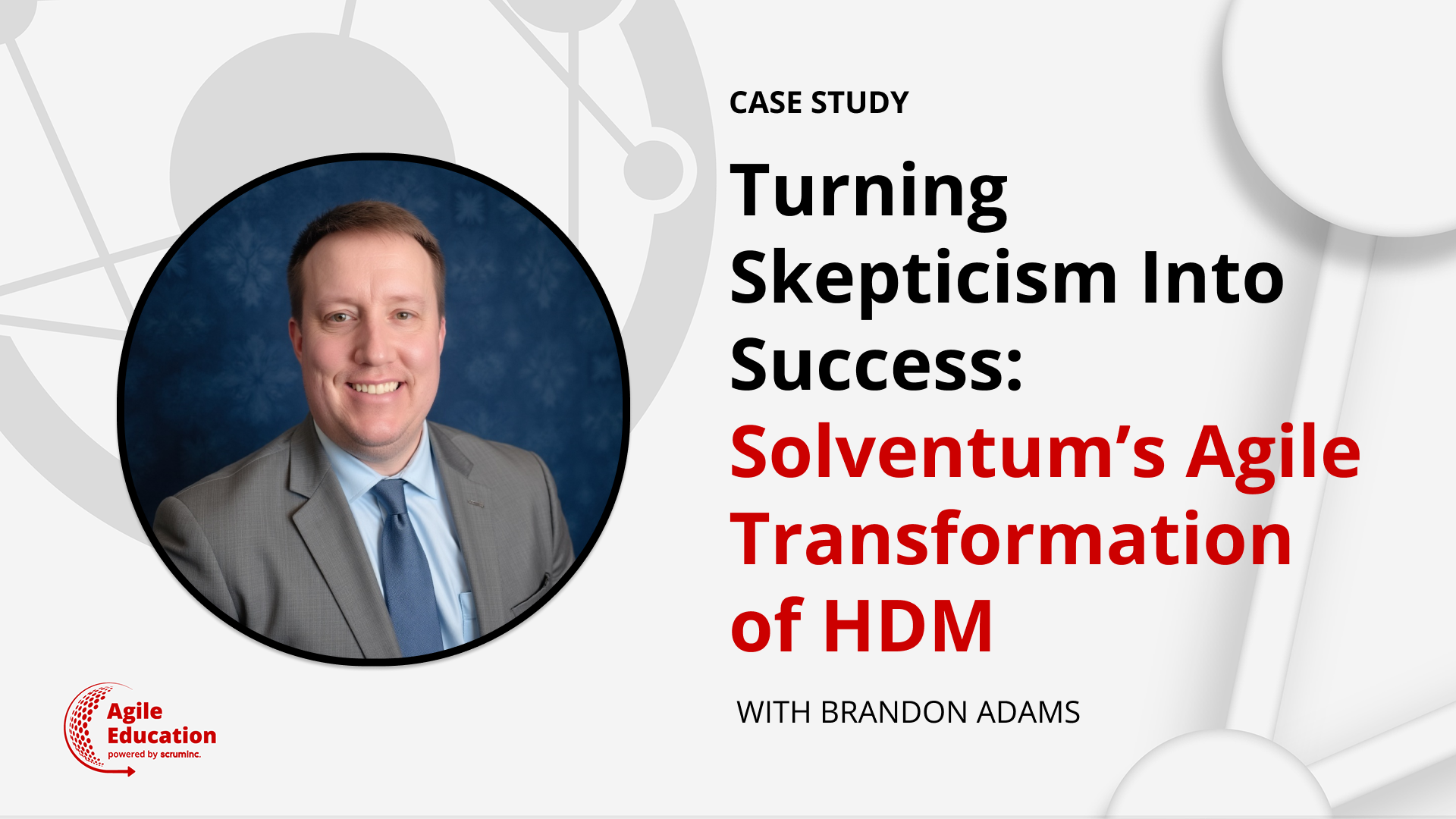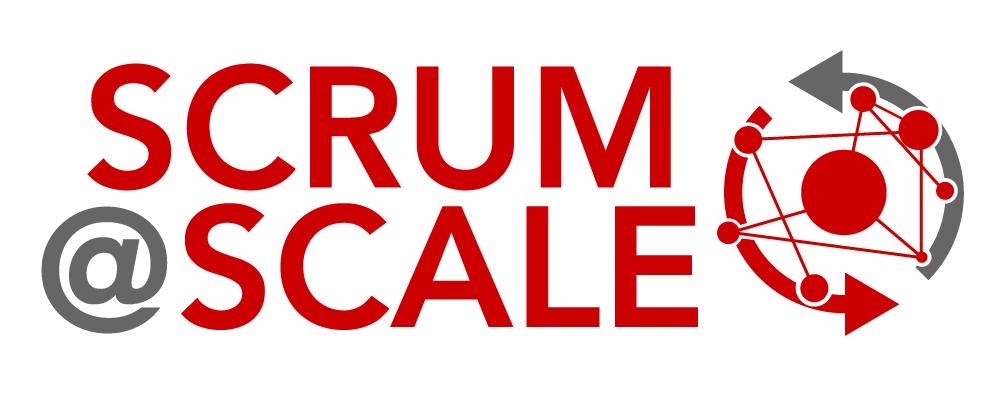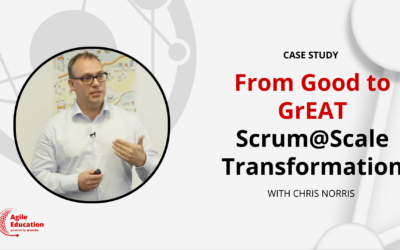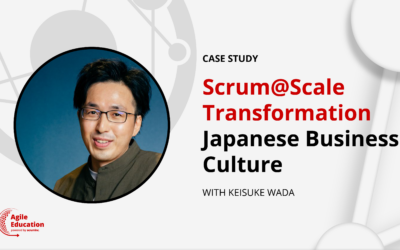Agile Education Case Study
Turning Skepticism Into Success: Solventum’s Agile Transformation of HDM
Solventum, formerly 3M Healthcare, is a global leader in healthcare and software development, reporting $8.67 billion in annual profit. Its Health Data Management (HDM) System, a flagship product generating $30 million annually, faced serious challenges. Testing bottlenecks, fragmented data, and skepticism toward automation slowed delivery and raised costs. To overcome these issues, Solventum partnered with Scrum Inc. trainers to transform HDM development and QA processes.
CASE STUDY SNAPSHOT
Industry: Healthcare, Software Development
Organization Size: Large
Topic: Continuous Improvement, Scaling Scrum, Empowering Teams, Agile Automation
Date: August 2025
Trainer Bio: https://agileeducation.org/trainer/brandon-adams/
Case Study Summary
Solventum, formerly known as 3M Healthcare, is a global leader in healthcare and software development with annual profits of $8.67 billion. Among its most valuable offerings is the Health Data Management (HDM) System, a product that generates $30 million annually and serves as a critical tool for Health Information Managers.
When the HDM team found itself mired in testing bottlenecks, fragmented data practices, and a culture skeptical of automation, leadership brought in Scrum coaches to guide a transformation. What followed was a dramatic shift in both process and mindset. By introducing Scrum practices, hosting Kaizen events, and embracing automation, the team achieved striking results: 252 days of testing eliminated, $600,000 in cost savings, over 100,000 patient records generated in minutes, and 75 percent automation coverage of a 2,000-case test suite.

Challenges
The HDM System was designed to simplify the workflows of Health Information Managers. It offered automated data collection, real-time demographic imports, customizable reporting, role-based security, and integration with compliance systems. However, despite its robust design, development was constrained by a traditional waterfall model. Rigid timelines, delayed feedback, and limited adaptability slowed innovation and made it difficult to meet changing healthcare needs.
The drawbacks were most evident in quality assurance. Engineers and analysts manually created test data, often spending hours to produce only a few records. Each required more than 100 unique inputs. With no shared database, every team member built and maintained separate data sets. In addition, the QA team faced a daunting 2,000-case manual test suite. Regression, stress, and smoke testing could take up to two months, even with five dedicated analysts.
To make matters worse, skepticism about automation ran deep. Many believed HDM was too complex to automate. Early efforts were dismissed as unrealistic, reinforcing the perception that manual testing was the only option.
The Transformation
The turning point came when Scrum Master Brandon Adams and Product Analyst Daniel Hudson began leading Kaizen events to address the testing bottlenecks. Their first focus was patient data creation. Adams developed an AutoIt script that generated 20–30 records in 45 minutes. Hudson built on this with the HDM Patient Generator Tool, which could create more than 100,000 records in minutes. As a result, the team quickly moved from manually built datasets to centralized repositories that scaled to any scenario. What once took hours, or even days, was reduced to minutes.
With data creation streamlined, the team turned to the massive QA test suite. After evaluating several tools, they selected Ranorex for its intuitive interface and compatibility with legacy C++ and Delphi codebases. With Ranorex, they automated 75 percent of the 2,000 test cases. Consequently, regression testing that had taken two months was reduced to one week, managed by a single QA engineer.
The technical gains were impressive, but equally important was the cultural shift. The success of automation projects began to reshape the team’s beliefs. Stories of faster testing cycles and lighter workloads spread quickly. What was once thought to be impossible was now celebrated as essential. Ultimately by embracing Scrum practices and fostering continuous improvement, the team built a new culture where innovation and automation thrived.
Results
By the end of 2024, the impact of these changes was undeniable. The team had saved an estimated 252 days of testing and reduced costs by $600,000. What had been a labor-intensive, slow-moving QA process was now lean and highly automated. Test data creation, once an all-day task, could now generate more than 100,000 records in minutes. A five-person QA team had been reduced to a single engineer, and testing cycles that used to last two months were completed in just a week.
Equally important, the mindset transformation was profound. A product once dismissed as “too complex to automate” was now seen as a scalable, automatable system critical to Solventum’s success. The HDM team emerged not only more efficient but also more confident in its ability to adapt and innovate.
Lessons Learned
The Solventum experience offers lessons for any organization facing similar constraints.
1. Scrum and continuous improvement practices can unlock innovation even in highly regulated, legacy environments.
2. Empowering individuals to experiment and lead change initiatives can catalyze transformation across an entire team.
3. Automation, often seen as unattainable in complex industries, is both achievable and impactful when approached iteratively.
4. The cultural shift from resistance to embrace is as critical as the technical tools themselves.
Conclusion
The HDM team’s journey reflects the power of combining Agile principles with automation in a legacy healthcare environment. By moving away from waterfall practices, Solventum eliminated bottlenecks, reduced costs, and accelerated delivery. What began as an uphill battle against skepticism and inefficiency ultimately became a story of innovation, agility, and measurable impact.
About Brandon Adams
Brandon Adams is a Registered Scrum Trainer, Scrum Master, and Product Owner with over a decade of experience leading agile transformations in healthcare software development. At 3M, he has served as a servant leader across multiple agile teams, implementing Scrum practices that doubled team velocity and significantly reduced testing turnaround times. Recognized as one of 3M’s top Scrum Masters, Brandon has driven innovation through automation frameworks, Six Sigma initiatives, and cross-functional collaboration. His leadership blends deep technical expertise with a disciplined approach shaped by 17+ years of military service as an AH-64D Apache pilot and officer. Brandon’s commitment to continuous improvement and team empowerment exemplifies the values of Scrum Inc. and agile excellence.
More Scrum@Scale Case Studies
From Good to GrEAT – Chris Norris
Agile Education Case Study From Good to GrEAT with Chris Norris Discover how Chris Norris dramatically improved the eStore development process for a large food and beverage company through the creation of an Executive Action Team (EAT). This case study demonstrates a...



